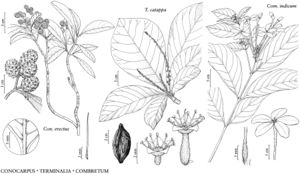Combretum
Iter Hispan., 308. 1758. name conserved
| Taxon | Illustrator ⠉ | |
|---|---|---|
 | Conocarpus erectus Terminalia catappa Combretum indicum |
Scandentshrubs or lianas [shrubs, occasionally trees], without pneumatophores. Stems elongate, wandlike, equal; twigs hairy, hairs short-to-elongate, combretaceous [or absent], and short-stalked, glandular [peltate scales]. Leaves persistent, opposite or subopposite and decussate [whorled]; stipules absent; petiole persistent, differentiated [or not] proximally, becoming spinelike in age, nectar glands absent; blade papery [to leathery], venation eucamptodromous to brochidodromous, apex acuminate to long-acuminate; without salt-excreting glands; pouch-domatia present or absent abaxially in axils of secondary-veins and midvein. Inflorescences terminal or axillary, spikes [racemes or panicles, sometimes nearly capitate]; bracteoles absent. Flowers conspicuous, each in axil of a bract, bisexual; hypanthium tubular and slightly broadened distally [to trumpet-shaped, narrowly campanulate, or cupshaped], free portion 38–80 mm, from apex of ovary, with sparse, gland-tipped hairs abaxially, [or with peltate scales, and/or simple, nonglandular hairs]; sepals [4] 5, green or pale green, triangular [ovate, sometimes nearly obsolete], glandular-pubescent [with peltate scales] abaxially, and with simple, nonglandular hairs; petals [0, 4] 5, white becoming pink then red [greenish white, yellow, orange, or purple], ovate to slightly obovate, [sometimes narrowly so, or suborbiculate], 9–25 mm, apex obtuse or rounded [emarginate]; nonglandular-pubescent [glabrous or with peltate scales]; stamens [4, 8] 10, included [to exserted]; nectary on inner surface of hypanthium near base, glabrous [pubescent]; ovary ± terete; style straight, adnate to proximal portion of hypanthial tube [free]; ovules 2–4 [–6]. Drupes terete, ellipsoid or ovoid [oblong], fleshy [dry], ridged or winged; ridges or wings [4] 5, poorly to well developed; hypanthium and calyx deciduous.
Distribution
Introduced; Florida, South America, Asia, Africa, n Australia, pantropical
Discussion
Species ca. 255 (1 in the flora).
Combretum is naturalized in southern Florida; it is native pantropically but absent in the Pacific Islands.
Selected References
None.